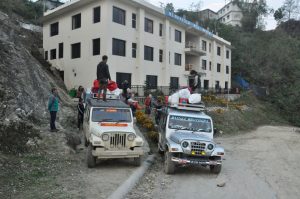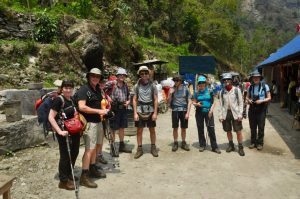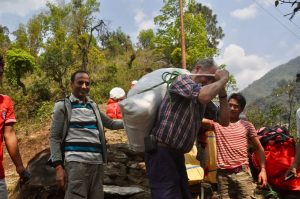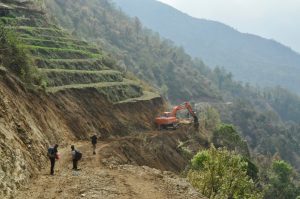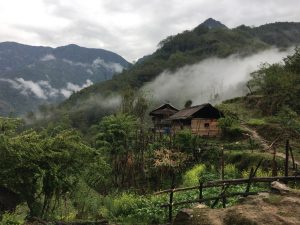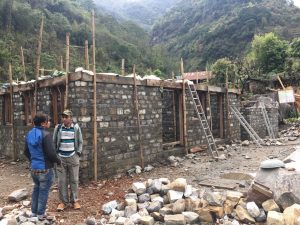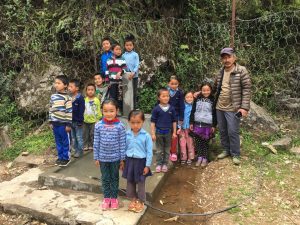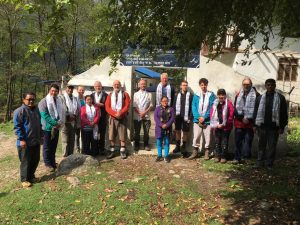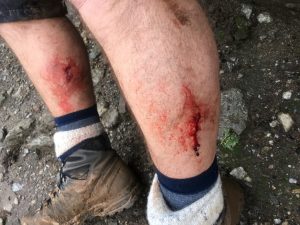I had forgotten just how hard the first day is trekking from Hapukhola to Kewang!
The day started at 5.00am when the alarm went off, waking us so that we would be ready for departure at 6.00. Breakfast was coffee and three slices of lightly toasted bread but no butter and only luminous red jam after I had eaten my blank toast. It didn’t need either butter or jam as it was slightly sweet.
Two jeeps arrived with eight porters and the members of the REED team who were accompanying us and we loaded our kit on to the roofs of the two vehicles. The ten of us were to go into one while the thirteen Nepalis were to squeeze in the other.
The first 35km of the journey saw us retracing our route of Friday night towards Phidim. At the first opportunity we left the main road on to a side road that would take us to Hapukhola. Initially it was tarmaced but that soon ran out and we were treated to a rollercoaster ride for two hours as we descended one hill, crossed a river and climbed another. At times it was a really rough journey and I found there were times when I really had to concentrate hard, and I was in the front seat with Jonathan who had to sit with his legs either side of the gear stick, an experience he seemed to enjoy.
We arrived at Hapukhola an hour ahead of schedule, 10.30. Time for noodle soup before we hit the trail.
As the hottest part of the day approached, we set out climbing steeply for a while above the Hapukhola River. It was hot, and very humid. It did not take me long to realise that I was going to find it hard. To be honest, I had not really prepared myself for this trek. I had been more concerned about the paperwork preparation rather than any physical work, other than a couple of outings since I got back from Vietnam. I was also carrying far too much weight, not in my rucksack, but on my body. A wake up call, perhaps.
Having gained some height the path then contoured around the hill before dropping to another river, after which there was a long, steep climb up to Appdada. I really struggled on this climb, breathing very heavily as I pulled my frame up each painful step. Along with the physical difficulty, I was now struggling mentally with the task I was embarking on. Self-doubt. A cup of tea and some cake improved my physical and mental well-being for a while but the effects soon wore off as we climbed further but less steeply for the next two hours.
We eventually turned round a bluff, which marked the start of the village of Kewang. I had fond memories of this village when I visited and stayed there two years ago. It was a green and well-cared for village. Now a road has sliced right through the middle of it destroying anything in its path and laying huge tracks of land to waste. A giant monster has ravaged the land and left a desolate wasteland in its wake. And that is all it has done. Nothing more, and inhospitable to any vehicle that might be brave enough to attempt to travel on it. It will be many years before the road has anything resembling a surface and, thus will remain as an evil scar. If my mood was fairly black before, this site made it worse.
By the time we reached the school playground where we were camping night was approaching fast. It had taken us six and a half hours of hard graft to reach this point. Putting the tents up in the rapidly fading light proved to be interesting, but we succeeded. It was good to relax in the lodge and an early night was required after we had eaten.
The road was still playing on my mind. The people of Kewang want it, and I can understand that, but what will happen when the road reaches further villages? If tourism takes off in this area, Kewang will suffer. At the moment it is a natural overnight stopping point for those trekking towards Kangchenjunga. Once the road is fully functional, everybody will bypass the village in favour of going further towards their goal. With these thoughts I went to sleep to be rudely awakened by dogs barking at 1.15, disturbed by lightening and distant rumbles if thunder. Fortunately, the disturbance did not last long and I had a good night’s sleep.
After breakfast, we set out on our journey to Yamphudin on the lovely path that once ran all the way through the village. It was not long before we hit the road again and the journey became a less pleasant trudge. This road took us to the summit of the first pass. Near the summit we came across the monster responsible for all the damage, a large digger slicing huge chunks out of a terrace already planted with maize, and spilling it on the downhill side of the road to make up the width.
At the top we took a rest before heading down the other side. We thought we could now walk down the original path but we again found ourselves forced to follow the road until it ran out. Then we had to pick our way through steep, damp greenery until we could pick up the path below. It was slightly precarious.
Just before the next climb we stopped at a lodge for tea while watching the porters play Karam, a cross between pool and shove halfpenny. We spent at least half an hour there.
The next climb was not too long but, although I was walking better than yesterday, I was still slower and more laboured than I would have liked. At the top we could look down on Yamphudin below. The descent to get there was long and steep and took us through thick woodland, woodland we have been warned that will rapidly disappear with the building of the road.
We reached the village in time for lunch and then set about putting our tents up before it rained. We just about managed it.
Later in the afternoon a number of us popped a little way up through the village to the site of the new health post that HTUK is building. They have got to above the windows and must soon be ready to start work on the roof timbers. It is going to be great and a super asset to this lovely community. We met the elderly lady who donated the land for the new health post, sitting on her porch. It is such a generous gesture as she is unlikely to benefit for very long from the facility but she will have bequeathed something very important for her community.
In the evening we had a lot of fun playing Chameleon in the lodge.
The next morning, immediately after breakfast, we headed up the steep path to Kangchenjunga Basic School. I soon began to realise that I was finding this very difficult and decided that I was committing my body to strenuous exercise when all it wanted to do was digest its breakfast. I really had no energy for walking up a steep hill and found I was breathing really heavily and needed to rest. I suggested the others went on ahead but Ian insisted on staying with me. A little further up Harry, Ross and Jonathan hung back to join me and Jonathan took my rucksack. Even without any weight on my back I still found it difficult despite being treated to some hazy views of distant glaciers and snowy peaks.
I was glad to have eventually reached the school. For a time I really thought I was going to have to turn back. I was feeling really disappointed with my performance.
Despite the fact that the school was not officially open, the majority of pupils turned up because of our visit. They were delightful and were very communicative and eager to practice their English. Their faces were open and smiling, happy children in their school environment. And what an environment, what a location with stunning mountain views from their own lofty position.
We sat on benches on the playground and met the head teacher, chairman of the SMC and parents over tea and biscuits. They are all very grateful for the support given by REED and HTUK. We were pleased to see the new water supply functioning. It appears that they managed to get somebody else to fund the 500m of black plastic pipe they needed, and with the community contribution in the building of the standpipe they had enough funds to rebuild the toilet, which was damaged in the earthquake.
Their concern now is that the children do not have a hot snack in the middle of the day. Some bring one with them to school but by the time they eat it it is cold. This is making some children ill in the afternoon. As there are only twenty children in the school, I don’t feel that it would cost a great deal to set up a snack fund, particularly if the facilities of the lodge just below the school could be used by a rotating mothers’ group.
After formal presentations and photos, we headed back down the hill for lunch.
In the afternoon we visited Kangchenjunga Secondary School, on whose playground we were camping. This school is ideally placed and has relatively good facilities, although the whole school could do with a new coat of paint. There were no children for us to observe but we toured round the classrooms. Very few have electricity and for those that do, it did not seem to work. I fear for the long term effects that dingy classrooms might have on the eyesight of the students. It was very hard to gauge the quality of the school without seeing teachers in action and children in situe.
After the tour we gathered in one of the larger classrooms for a formal meeting. Quite a large crowd turned up, including the head, teachers, SMC members, parents, local officials and some residents, including teachers, from Kewang, a village outside our working area. There were many introductions, lots of garlands and a formal request for a snack fund. The way they envisage it working is the HTUK provides an initial sum of money that would be managed by the SMC. This money would be invested in order to provide interest, which would be used to provide daily snacks. The school would need to purchase some cooking items. In addition, local people would be able to take out a loan from the managed fund for which they would be charged interest so that the capital fund is maintained. I think this would work but I do feel that there would need to be investment in the fund from the community members, which would enhance it and, perhaps, reduce the amount of investment from HTUK.
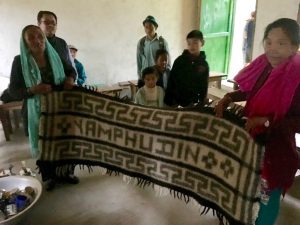 At the end of the event I was presented with a rug made from sheeps wool with the name, Yamphudin, woven along its length. The ladies who made it were there and they told me it had taken them three days to weave.
At the end of the event I was presented with a rug made from sheeps wool with the name, Yamphudin, woven along its length. The ladies who made it were there and they told me it had taken them three days to weave.
That night, and again the following morning I had an upset stomach, which possibly accounted for my disappointing performance going up the hill that morning.
We had a lot of rain in the night and it continued for much of the day. Low cloud hung around the mountains and the rain was pretty constant. The wet weather brought out the leeches and several seemed to find their way inside my waterproof trousers. I had six in total. They always look much worse than they are. There is no pain involved, no after infection and once they have had their fill they just drop off. The wound just bleeds for a long time afterwards as they inject an anti-coagulant.
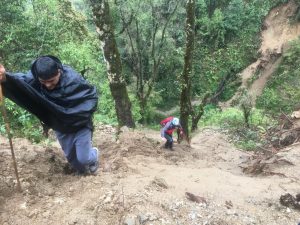 While we had been in Yamphudin the monster eating up the land to make a road had made rapid progress. Unfortunately, no consideration had been taken regarding the path we were walking on. It was now lost under tons of soil, rock and broken trees, discarded without care. Hence, we had to find our way over steep, very unstable ground that was looking for any opportunity to slip lower. It was quite precarious.
While we had been in Yamphudin the monster eating up the land to make a road had made rapid progress. Unfortunately, no consideration had been taken regarding the path we were walking on. It was now lost under tons of soil, rock and broken trees, discarded without care. Hence, we had to find our way over steep, very unstable ground that was looking for any opportunity to slip lower. It was quite precarious.
On a positive note, I was walking much better, I felt more energised and able to maintain my pace. I wasn’t quite as quick up the first hill as I was two years ago but speed is not the be all and end all. It is how you feel both physically and mentally, and I was feeling good.
That night, because we had a lot of wet kit and our tents were wet, we stayed in the lodge in Kewang, providing us with a little more comfort and an opportunity to dry things out a bit.
The last day of our walk out found us walking in really sultry conditions. It was incredibly humid despite the cloud. Eventually the sun did come out and then it was really hot. I still felt good.
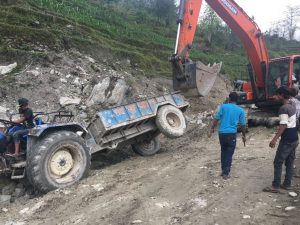 The jeeps were at Hapukhola to meet us and after a bowl of noodle soup we embarked on the bumpy ride back to Taplejung. It was not all plain sailing as the recent heavy rain had turned sections of the road into a very sticky mess. We came across a lorry stuck up to its axels in mud. A tractor and trailer that tried to squeeze by or move to the side, also got stuck and added to the mayhem. Meanwhile traffic waited either side for something to happen. I say traffic, there may have been four vehicles either side of the blockage. Eventually a digger came to the rescue and pulled the tractor out and then the lorry. Before any vehicles could continue their journey the huge ruts has to be filled. All a bit of fun that added an hour to our journey. Long before we got back to Taplejung more heavy rain fell from the skies.
The jeeps were at Hapukhola to meet us and after a bowl of noodle soup we embarked on the bumpy ride back to Taplejung. It was not all plain sailing as the recent heavy rain had turned sections of the road into a very sticky mess. We came across a lorry stuck up to its axels in mud. A tractor and trailer that tried to squeeze by or move to the side, also got stuck and added to the mayhem. Meanwhile traffic waited either side for something to happen. I say traffic, there may have been four vehicles either side of the blockage. Eventually a digger came to the rescue and pulled the tractor out and then the lorry. Before any vehicles could continue their journey the huge ruts has to be filled. All a bit of fun that added an hour to our journey. Long before we got back to Taplejung more heavy rain fell from the skies.
When we got into the hotel there was frantic washing of kit in the hope that we could get it dry by the morning when we would start the next phase of our journey.
During the course of the last few days I have openly admitted that I am carrying too much weight, not in my rucksack but in front of me. I did not prepare adequately for a trek and I only have myself to blame. Kate came up with the idea of a sponsored slim, declaring that I should lose 15kg by Christmas. She drew up a formal agreement that I signed in front of witnesses. Struggling has really given me a kick up the arse. I will be much lighter by Christmas and the Himalayan Trust UK will benefit as a result.

